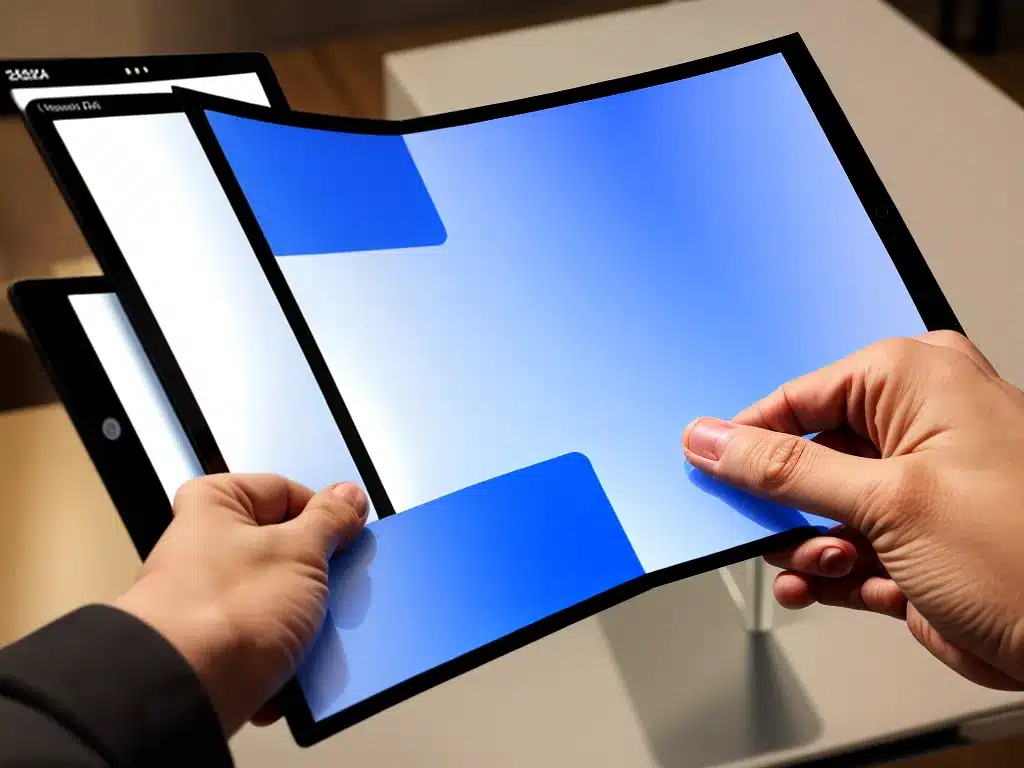Introduction
Foldable screens represent an exciting new evolution in smartphone design. After being limited to prototypes and niche devices for years, foldable screens are now poised to potentially enter the mainstream in 2024. But will they truly cross over to widespread adoption or remain a novelty item embraced only by early tech adopters? There are several factors that will determine if foldable screens reach critical mass in 2024.
Current State of Foldable Screen Technology
The technology for foldable screens, also known as flexible displays, has been in development for over a decade. The basic idea is to create a display that can bend and fold without being damaged. This is achieved through the use of OLED (organic light-emitting diode) screens, which use thin, flexible panels unlike the rigid glass panels in typical smartphone displays.
While companies like Samsung and Lenovo launched foldable devices as far back as 2011, those early attempts faced issues like poor screen durability and unsightly creases on the displays. It’s only been in the past 2-3 years that foldable screen technology has advanced enough for companies like Samsung, Huawei, Xiaomi, Oppo, and Motorola to release foldable smartphones that are viable for everyday consumer use.
Current technical capabilities of foldable displays include:
- OLED panels that can bend extremely tight without damage.
- Plastic polymer substrates that replace rigid glass.
- Advanced hinge designs to allow screens to fold and unfold smoothly.
However, there are still some limitations:
- Creasing – Repeated folding can cause creases on the screen.
- Durability – Long term durability is still a concern, especially for the hinge.
So in summary, the technology has come a long way but still needs refinement before it can be implemented flawlessly in a smartphone form factor.
Market Landscape Heading Into 2024
At the moment, foldable phones occupy an ultra-premium niche segment of the smartphone market. Current models retail for $1,000 and up, over double the average price of premium flagship phones from Apple, Samsung, and others. Unsurprisingly, sales have been limited.
But several signs point to foldable phones making inroads into the mainstream over the next 2 years:
-
Improving durability – As mentioned, durability is starting to reach acceptable levels. And continued materials science advancements by 2024 could improve it further.
-
Price decreases – Experts predict the retail pricing of foldable phones will start approaching the $700-800 range in 2024. This could entice more consumers to try the novel form factor when the price is no longer prohibitive.
-
More brands onboard – Samsung has dominated, but competitors like OPPO, Xiaomi, and Motorola are starting to release their own foldables. More options from different brands will help drive demand and awareness.
-
Innovative form factors – New form factors beyond just outward folding screens could emerge, like Honor’s concept of a screen that folds both ways, or a smartphone with multiple foldable screens.
As such, by 2024 we could see foldable phones go from being 1% of the smartphone market to a still niche but far more visible 5-10% of the market.
Key Factors That Will Determine Mainstream Viability
There are 3 critical factors that will decide if foldable phones can become a mainstream device owned by more than just tech enthusiasts in 2024.
Durability
- Foldable displays still delicate compared to glass screens.
- Hinge and creasing remain weak points prone to breaks with frequent folding.
- Most consumers expect phones to last 3+ years through daily use and occasional drops.
- If durability does not significantly improve, foldables may remain unsuitable for everyday use.
Pricing
- Current prices above $1,000 are too expensive for many buyers.
- But prices could fall to $700-800 range by 2024.
- Making foldables affordable could dramatically expand addressable market.
Software & App Integration
- For larger foldable screens to be truly useful, apps & software need seamless integration and continuity between folded and unfolded states. This requires operating system-level support.
- Google and Android have been working on optimizations for foldables like Flex Mode and expanded APIs.
- How quickly and effectively Android and major apps like social media, video streaming, and productivity software adapt will impact the foldables user experience.
Outlook for Foldable Smartphones in 2024
Given the current trajectory, foldable phones have a strong chance of crossing over into the mainstream in 2024. But some key things need to happen first:
- Prices need to become affordable for the average premium device buyer.
- Durability, especially long-term, needs to hold up to everyday use.
- Android and app ecosystems need to be optimized for foldable displays.
If foldable tech can mature on those fronts, we could see foldable screen devices make up 15-20% of smartphones sold in 2024. This would firmly establish foldables as a major new device category.
However, if prices remain very high, durability issues persist, and software integration lags, then foldables may remain stuck as a niche product. But given the amount of investment and effort going into foldables, the more likely scenario seems to be that foldable screens will become a common sight in 2024.













